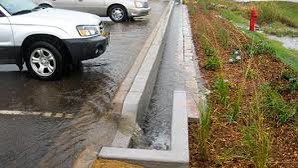Difference between revisions of "Level spreaders"
Jump to navigation
Jump to search

Jenny Hill (talk | contribs) m |
Jenny Hill (talk | contribs) m |
||
| Line 1: | Line 1: | ||
| − | [[File:Levelspread.jpg|thumb|This clever design incorporates a level spreading device after a [[curb cut]] has concentrated flow. This kind of treatement train approach would provide an opportunity to provide [[ | + | [[File:Levelspread.jpg|thumb|This clever design incorporates a level spreading device after a [[curb cut]] has concentrated flow. This kind of treatement train approach would provide an opportunity to provide [[pretreatment]] at the point of concentration. Photo credit: [https://www.pca.state.mn.us/featured/when-it-rains-it-flows MPCA]] |
Level spreaders should conform to the following design criteria in order to ensure non-erosive sheet flow into vegetated areas such as [[vegetated filter strips]], [[swales]] or forested conservation areas<ref>Hathaway, J. M., & Hunt, W. F. (2006). Level Spreaders : Overview , Design , and Maintenance.</ref>. | Level spreaders should conform to the following design criteria in order to ensure non-erosive sheet flow into vegetated areas such as [[vegetated filter strips]], [[swales]] or forested conservation areas<ref>Hathaway, J. M., & Hunt, W. F. (2006). Level Spreaders : Overview , Design , and Maintenance.</ref>. | ||
Revision as of 16:19, 6 March 2018

This clever design incorporates a level spreading device after a curb cut has concentrated flow. This kind of treatement train approach would provide an opportunity to provide pretreatment at the point of concentration. Photo credit: [https://www.pca.state.mn.us/featured/when-it-rains-it-flows MPCA
Level spreaders should conform to the following design criteria in order to ensure non-erosive sheet flow into vegetated areas such as vegetated filter strips, swales or forested conservation areas[1].
The length of the level spreader should be determined by the type of filter area and the design flow:
- 1.4 m of level spreader length per every 0.01 cubic meter per second (cms) of inflow for discharges to a filter strip or turf conservation area;
- 4.3 m of level spreader length per every 0.01 cms of inflow when the spreader discharges to a forested conservation area.
- The minimum level spreader length is 4 m and the maximum is 40 m.
- The level spreader lip should be concrete, wood or pre-fabricated metal, with a well anchored footer, or other accepted rigid, non-erodible material.
- The ends of the level spreader section should be tied back into the slope to avoid overflow scouring or erosion around the ends of the spreader.
- The width of the level spreader channel on the up-stream side of the level lip should be three times the diameter of the inflow pipe, and the depth should be 20 cm or one-half the culvert diameter, whichever is greater.
- ↑ Hathaway, J. M., & Hunt, W. F. (2006). Level Spreaders : Overview , Design , and Maintenance.